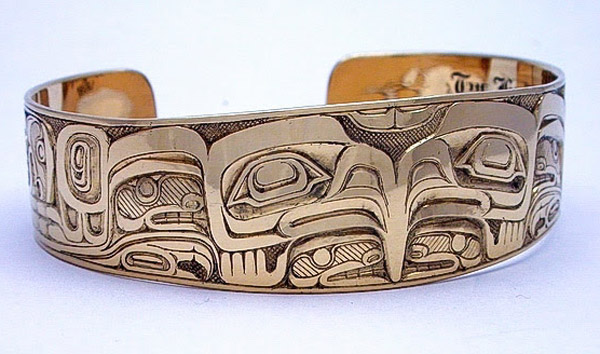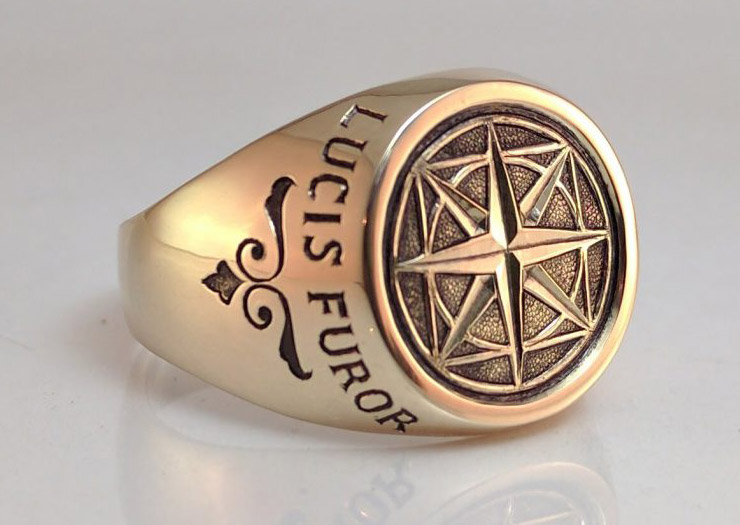Canadian Engraver And Artist Warren Smith Discusses His Designs And Creative Icons
With metallic tones and textures having such a widespread impact on the world of interior design, art and fashion, it’s no surprise that metals are perpetually chic. Yet beyond the shiny surface, metallic creations are a unique form of art, with hand engraving making its mark as a meticulous craft. As a Canadian hand engraver based in the Okanagan, British Columbia, Warren Smith of Coast Handworks is a self-taught artist who takes his inspiration from the country’s rich First Nations cultures. Smith, who engraves everything from jewellery to handmade Haida art, spoke to Real Style about his artistic process. From his favourite materials to finding his creative energy right at home in beautiful B.C., Smith described the detailed workmanship involved in his unique creations.
Real Style: What was the original inspiration to pursue a career in hand engraving?
Warren: The impetus for my hand engraving career came from two of my passions colliding: working with metal as a journeyman machinist, and a deep love of, and connection to, Northwest Coast Haida art. My neighbour, Lia Grundle, was a personal friend of both Bill Reid and Robert Davidson, the renowned Haida artists. Her home was brimming with their pieces. The art had a deep and profound effect on me. I was a frequent visitor – it was practically like going to church!
After high school, I pursued and obtained a machinist ticket. Being a journeyman machinist proved to be good training through the years as I taught myself how to hand engrave in various mediums, including the toughest of all, metal.
Real Style: What are some of the biggest design challenges that you have faced?
Warren: The biggest challenge I face with hand engraving these days is bringing people’s ideas together into a cohesive, balanced, flowing design. Very often a customer will come to me with just a verbal description of what they would like hand engraved on their wedding band or signet ring. They’re usually wonderful ideas in theory, but in many cases I have to bring together elements that don’t initially sound as if they could be pleasing to the eye, so artistic interpretation becomes the challenge. But since people are entrusting me to make something beautiful and long-lasting, I’m honoured by the challenge.
I find my path to the design by reminding myself that, ultimately, this item is going to be a permanent representation of my skill as both an artist and an engraver. Having spent close to 25 years engraving in metal, technique is mostly second nature to me now. Muscle memory I can rely on, tools I can trust. But creating something that has a deep, personal meaning for a customer who’s trusting me to deliver – that’s the challenge.
Real Style: Do you have any preferred materials to work with?
Warren: Yes, any of the harder metals- steel, 10k, 14k gold, white gold. Hand engraving is about detail, and the harder the material, the more detail is possible. It’s like a sculptor preferring marble over butter. Without hardness, the level of detail has to be reduced simply because the material either won’t support it, or it moves away from the tool. A soft metal like silver can be engraved, but there’s not much satisfaction in it.
Real Style: What are your creative and artistic icons and inspirations?
Warren: Well, first and foremost, the Haida artist Robert Davidson. His excellence in all mediums is unsurpassed. Then there’s a German-American engraver named Louis Nimschke who lived in New York in the 1880s. He was a prolific firearms engraver who was really responsible for the American style of engraving. Heinz Funk, for sure, another German engraver still living in Germany but mostly retired – his work is creative, precise and extremely well executed.
Real Style: Your designs are proudly engraved in Canada. How do you find this experience of creating your designs locally?
Warren: I think the innate openness of Canada really helps. We’re open to exploring and absorbing different ideas. Different arts, cultures and ethnicities all have this common ground of being Canadian.
It’s funny, but hand engraving styles have always been a regional thing. Designs that are popular in one area won’t sell elsewhere. Larger cities tend to request more modern designs and the smaller towns more traditional ones. One thread that I have noted is the sense of belonging to a tribe.
Lately, the imagery being used in hand engraving is closely connected to tattoo designs. I’m sensing a global movement of people wanting to express themselves outwardly with either jewellery or tattoos, to tell the world that they belong to a certain tribe or common mindset. What we wear on our outside expresses who we were, who we are and who we want to be. But that’s what Canada has always been about for me. Welcome to the party!
Real Style: Have any travel destinations influenced your work?
Warren: Nothing exotic. Being born and raised in Vancouver, British Columbia has been the biggest influence in my work. I’ve travelled all over the province just to soak it all in and be inspired. Rainforests, rocky coastal shores, the interior, the Cariboos and the ocean all run through my veins. There are a lot of diverse cultures in there, but all with an overarching west coast mindset that I’m glad to be a part of.
Besides that, my lifelong passion for Haida art means my most influential travel destination is my backyard.
Real Style: Describe the most memorable or significant piece you have ever created.
Warren: There are two pieces, or series of pieces, I am most proud of, the first being a bracelet I made for Becky Harcourt, wife of former BC Premier Mike Harcourt. I created a design that encompassed elements of her life and family. I pulled out all the stops and surrendered entirely to the creative process, pushing myself beyond anything I’d previously done. It took me 110 hours – nothing else has absorbed me like that. When I look back at some of my earlier pieces, I often note how much I’ve progressed, but that particular piece still stands up today.
But more recently, I’m extremely proud of the rings I’ve been doing. I feel as if I’m stretching out as an artist and seeing each wedding band or signet ring as a canvas. I’ve always been reluctant to call myself an artist but after twenty or thirty years of attempting to master this set of skills, I’m starting to sense a shift in my approach to designing, and to cutting the designs. The entire process is much more organic and fluid.
Photos: Warren Smith


